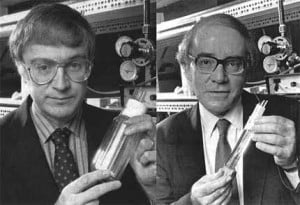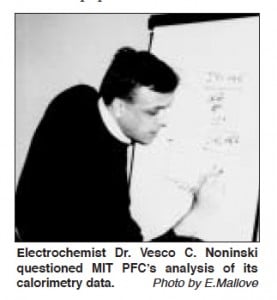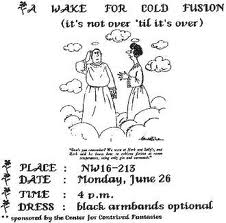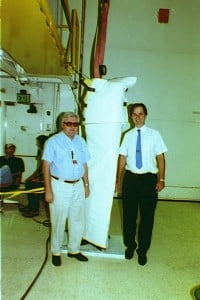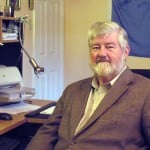Cold Fusion – NASA – LENR Future
The Chief Scientist of NASA and the Chief Scientist NASA Langley Porter Research Institute move forward with the energetics of LENR – cold fusion as the solution to problems like global warming, transportation, energy, and NASA space missions planned yet unrealized.
NASA has a broad prerogative, their mission is to:
- Protect the Earth
- Develop a permanent extraterrestrial human presence
- Enable commercial ventures to advance into space
- The science of LENR will give us electricity without generators and controlled heat without a carbon signature. Overpopulation, global warming, and environmental damage are the greatest dangers to Earth. Converting to LENR power and human expansion into space is the solution.
- The energetics of LENR will enable a new generation of launch vehicles and platforms that bring payload costs down from thousands per pound to dollars per pound. The compact size of LENR power, abundance of LENR fuels, and safe clean operation allows ease of use for space colonies.
- The wide range and ease of availabity of LENR technology, 3D- Printing technology, advanced robotics, and the abundance of natural resources will allow private sector interests to thrive in space without a standard profit motive. Humanity as a space faring race will develop new economic models.
NASA Names Waleed Abdalati As Agency’s New Chief Scientist (nasa)
The NASA Office of Chief Scientist was discontinued in 2005 and reinstated in 2011.
NASA Administrator Charles Bolden has named Waleed Abdalati the agency’s chief scientist, effective Jan. 3, 2011. He is currently on leave from his position as director of the University of Colorado’s Earth Science and Observation Center, which carries out research and education activities on the use of remote sensing observations to understand the Earth.
His research has focused on the use of satellites and aircraft to understand how and why Earth’s ice cover is changing, and what those changes mean for life on our planet.
His appointment as Chief Scientist marks a return to NASA for Dr. Abdalati, where he worked from 1996-2008. From 2004-2008, he was head of the Cryospheric Sciences Branch at NASA’s Goddard Space Flight Center in Greenbelt, Md., where he supervised a group of scientists who carried out research in the development and analysis of remote sensing observations to study the behavior of ice sheets, sea ice, and glaciers.
From 2000-2004, he managed NASA’s Cryospheric Sciences Program at NASA Headquarters, managing the agency’s interests and research investments in cryospheric research, and serving as program scientist on the ICESat and RADARSAT missions.
From 1996-2000, Dr. Abdalati was a researcher at Goddard in the Oceans and Ice Branch, where he analyzed satellite and aircraft measurements of glaciers and ice sheets to assess their contributions to sea level rise. He also served as deputy project scientist for NASA’s Ice Cloud and land Elevation Satellite (ICESat).
In the mid 1980s, before returning to graduate school, he worked as an engineer in the aerospace industry, designing, analyzing and testing components of various spacecraft and submarine systems.
Dr. Abdalati has received various awards and recognition, most notably the NASA Exceptional Service Medal and The Presidential Early Career Award for Scientists and Engineers from the White House.
Office of the Chief Scientist
Functional Leadership Plan (nasapdf)
“The Chief Scientist, located in the Office of the Administrator, serves as the principal advisor to the NASA Administrator in science issues and as interface to the national and international science community, ensuring that NASA research programs are widely regarded as scientifically and technologically well founded and are appropriate for their intended applications.“
- Goal 1: Provide oversight to assure that NASA funds only the most exemplary and meritorious science to enable NASA to achieve its mission.
- Goal 2: Lead strategic planning for new and revolutionary research directions for NASA.
- Goal 3: Maintain and foster communication links with the scientific and technical communities at large, including other Federal science agencies, academic, industrial, international partners, and the general public.
- Goal 4: Act to encourage cooperation and synergy among the science programs and between science programs and other NASA programs.
- Goal 5: Lead and manage the Generate Knowledge cross-cutting process.
- Goal 6: Lead and manage the Communicate Knowledge cross-cutting process.
NASA Advisory Council Science Committee Meeting
March 3 and 4, 2011 (nasapdf)
NASA Chief Scientist Presentation
Dr. Waleed Abdalati, recently appointed NASA Chief Scientist, addressed the Science Committee and described his background in Earth Science, research on glaciers and ice sheets, remote sensing, and managing the cryospheric sciences branch at GSFC.
Dr. Abdalati stressed that he accepted the position in the hopes of making a difference and being useful as an advisor to the Administrator. He noted that Mr. Bolden had also expressed an interest in employing a Chief Scientist to address the complex relationships among the agencies. The functions of the new office are meant to be free from the burdens of implementation in order to take a broad agency view, and to offer a different perspective across directorates and centers. The Chief Scientist will also identify where activities span directorates, and where these activities may be leveraged, and also “orphan science” such as life and microgravity sciences, which now resides within ESMD, to address the role of science in exploration.
The Chief Scientist will provide advocacy on behalf of science in general, through a philosophical approach. The office should be perceived as an additional avenue for communication, not an opportunity for an end-run. The main goals are to maximize science return for investment of resources; the objective is to put NASA science at the forefront. As the space program is transitioning, there is an opportunity to highlight this.
Authors note: Many managers cite rising costs of launch platforms as problematic. Read the full NASA Advisory Council Science Committee meeting notes for a deeper understanding.
“Scientists to hold bake sale for NASA” (MSNBC News) Tech article by Clara Mskovitz, June 8, 2012
In his fiscal year 2013 budget proposal, President Obama has requested $17.7 billion for NASA. The 2013 budget proposal submitted would cut funding for NASA’s planetary science projects by about $300 million.
Chief Scientist at NASA Langley
The Chief Scientist at NASA Langley is Dennis Bushnell; a bit of his bio, career, and recent history of actions is worth noting.
Bio: (nasa) Dennis M. Bushnell is the Chief Scientist at the NASA Langley Research Center where researchers are focusing on some of the biggest technical challenges of our time; global climate change, access to space and revolutions in airplanes and the air transportation system.
During his more than four decades at NASA, Dennis served the Gemini, Apollo, Viking and space shuttle programs. He invented and developed the riblet for speeding airflow across surfaces, an advance that led to turbulent drag reduction in aeronautics technology. He had six patents and has authored more than 250 publications and major presentations often on the future of technology and the impact it will have on our society.
He has received awards from professional groups, governmental agencies and academia, including the NASA Exceptional Scientific Achievement and Outstanding Leadership Medals and Distinguished Research Scientist Awards. He is a member of the National Academy of Engineering, and a Fellow of the American Society of Mechanical Engineers, the American Institute of Aeronautics and Astronautics, and the Royal Aeronautical Society.
Career: (link) Responsible for Technical Oversight and Advanced Program formulation for a major NASA Research Center with technical emphasis in the areas of Atmospheric Sciences and Structures, Materials, Acoustics, Flight Electronics/Control/Software, Instruments, Aerodynamics, Aerothermodynamics, Hypersonic Air breathing Propulsion, Computational Sciences and Systems Optimization for Aeronautics, Spacecraft, Exploration and Space Access.
Forty-nine years experience as: Research Scientist, Section Head, Branch Head, Associate Division Chief and Chief Scientist.
Author of 252 publications/major presentations and 340 invited lectures/seminars, Member of National Academy of Engineering, Selected as Fellow of ASME, AIAA and the Royal Aeronautical Society, 6 patents, AIAA Sperry and Fluid and Plasma Dynamics Awards , AIAA Dryden Lectureship, Royal Aeronautical Society Lanchester, Swire and Wilber and Orville Wright Lectures, ICAS Guggenheim Lecture, Israel Von Karman Lecture, USAF/NASP Gene Zara Award, NASA Exceptional Scientific Achievement and Outstanding Leadership Medals and Distinguished Research Scientist Award, ST Presidential Rank Award,9 NASA Special Achievement and 11 Group Achievement Awards, University of Connecticut Outstanding Engineering Alumni, Academy of Engineers ,Pi Tau Sigma and Hamilton Awards, Univ. of Va. Engineering Achievement Award , service on numerous National and International Technical Panels and Committees and consultant to National and International organizations.
DOD related committee/consulting assignments include USAF Rocket Propulsion Laboratory, BMDC, ONR, Intelligence Community/STIC, AFOSR, NRAC, NRC,WL, LLL, HASC, NUWC, DARPA, AGARD, ARL,IAT, AEDC, JANNAF, NAVSEA, Air Force 2025,AFSOC,Sandia ,SAB, Army War College ,ACOM Joint Futures ,SOCOM,TRADOC,SEALS,JFCOM,IDA,NDU,DSB and Army After Next.
Reviewer for 40 Journals and Organizations, Editor, Volume 123 of AIAA Progress Series “Viscous Drag Reduction in Boundary Layers.” Responsible for invention/ development of “Riblet” approach to Turbulent Drag Reduction, High Speed “Quiet Tunnels” for Flight-Applicable Boundary Layer Transition Research, Advanced Computational Approaches for Laminar Flow Control and Advanced Hypervelocity Air-breathing and Aeronautical Concepts with revolutionary performance potential.
Contributions to National Programs include Sprint, HSCT/SST, FASTSHIP, Gemini, Apollo, RAM, Viking, X15, F-18E/F [patent holder for the “fix” to the wing drop problem],Shuttle, NASP, Submarine/Torpedo Technology ,Americas’ Cup Racers, Navy Rail Gun, MAGLEV Trains and Planetary Exploration.
B.S. in M.E. degree from University of Connecticut with Highest Honors, Distinction, University Scholar (1963), M.S. degree in M.E. from University of Virginia (1967).U.S. Govt. ST
Recent History of Actions
“For Bushnell, Green Is Global, Personal” (nasa) by Jim Hodges 03.21.08
Statements by Bushnell
- “All of these things indicate that by 2100, we could be looking at an average temperature increase 6 to 14 degrees Centigrade,” adds Bushnell, Langley’s chief scientist. “At those temperatures, beyond 2100 all of the ice will melt and the oceans beyond 2100 could come up 75 to 80 meters, enough to drown the homes of some 2 ½ billion people globally.”
- “We would like to incite brainstorming on the part of the entire field,” Bushnell says. “I am soliciting, the (center) is soliciting any and all ideas, thoughts, comments about climate and energy. We want people to intuit, find, seek, identify, hunt an assembly of concepts of green energy generation, storage, conservation and transmission – the entire spectrum of approaches. We’re looking for ideas.”
- “There’s some thinking on the field that the next administration may take climate and energy far more seriously,” Bushnell says. “And so we’re involved in an effort at a very low level to do a ‘what-if-the-boss-asks’ planning exercise.
- “In other words, if the White House or the next administrator asks what could Langley do for energy, warming or whatever, it’s nice to have an answer.”
- “So, it’s sometimes good to work ‘what-if-the-boss-asks’ before he asks it. This is called due diligence homework.”
Read what NASA says about Cold Fusion (coldfusionnow)
“LENR the Realism and Outlook” (nasa) by Dennis Bushnell, Chief Scientist NASA Langley Research Institute.
Commercialization of Asteroids for Expansion into Space
“Extraterrestrial Mining Could Reap Riches & Spur Exploration” by Leonard David, SPACE.com (read)
- “We talk about asteroids as a source of palladium and platinum and rare metals.” says Peter Diamondis of Planetary Resources Inc. “They’re also a source of … the things we value as humans… air water; that which keeps us alive. Asteroids are primarily a resource for our life as we expand into space.”
- “Water sourced from asteroids will greatly enable the large-scale exploration of the solar system. Using the resources of space to expand into space is what will enable that bright future that we all dream of.” Eric Anderson, Co- founder.
Planetary Resources Inc.
X Prize’s Peter Diamandis, Space Adventures’ Eric Anderson, NASA astronaut Tom Jones, and Mars mission manager Chris Lewicki, backed by visionary investors James Cameron, Larry Page, Ross Perot want to develop our Solar System’s natural resources.
Credit: SPACE.com, Planetary Resources, NASA
http://www.space.com/15400-asteroid-threat-promise-space-venture-launches-video.html
The Future is Now!
Electrical current without generators using cheap abundant safe nuclear dense LENR fuels will enable next generation space-planes to use magnetic controlled plasma drives with a thrust magnitudes greater than chemical (400X). Mag Lev Launch will reduce costs and exhaust pollutants.
Plasma Rockets
“Plasma Propulsion in Space” by Eric J. Lerner, The Industrial Physicists magazine (pdf)
Rocketry: A comparative analysis
“PROPULSION SYSTEMS” A PRINCIPLES OF OPERATION OF ROCKET ENGINES (link)
Mag Lev Launch
The same electricity will enable mag lev launch platforms on the Earth, asteroids, moon, and Mars.
The Startram Project (link)
When I heard the learn’d astronomer,
When the proofs, the figures, were ranged in columns before me,
When I was shown the charts and diagrams, to add, divide and measure
…..them,
When I sitting heard the astronomer where he lectured with much applause
…..in the lecture room,
How soon unaccountable I became tired and sick,
Till rising and gliding out I wandered off by myself,
In the mysical moist night air, and from time to time,
Looked up in perfect silence at the stars.
by Walt Whitman

